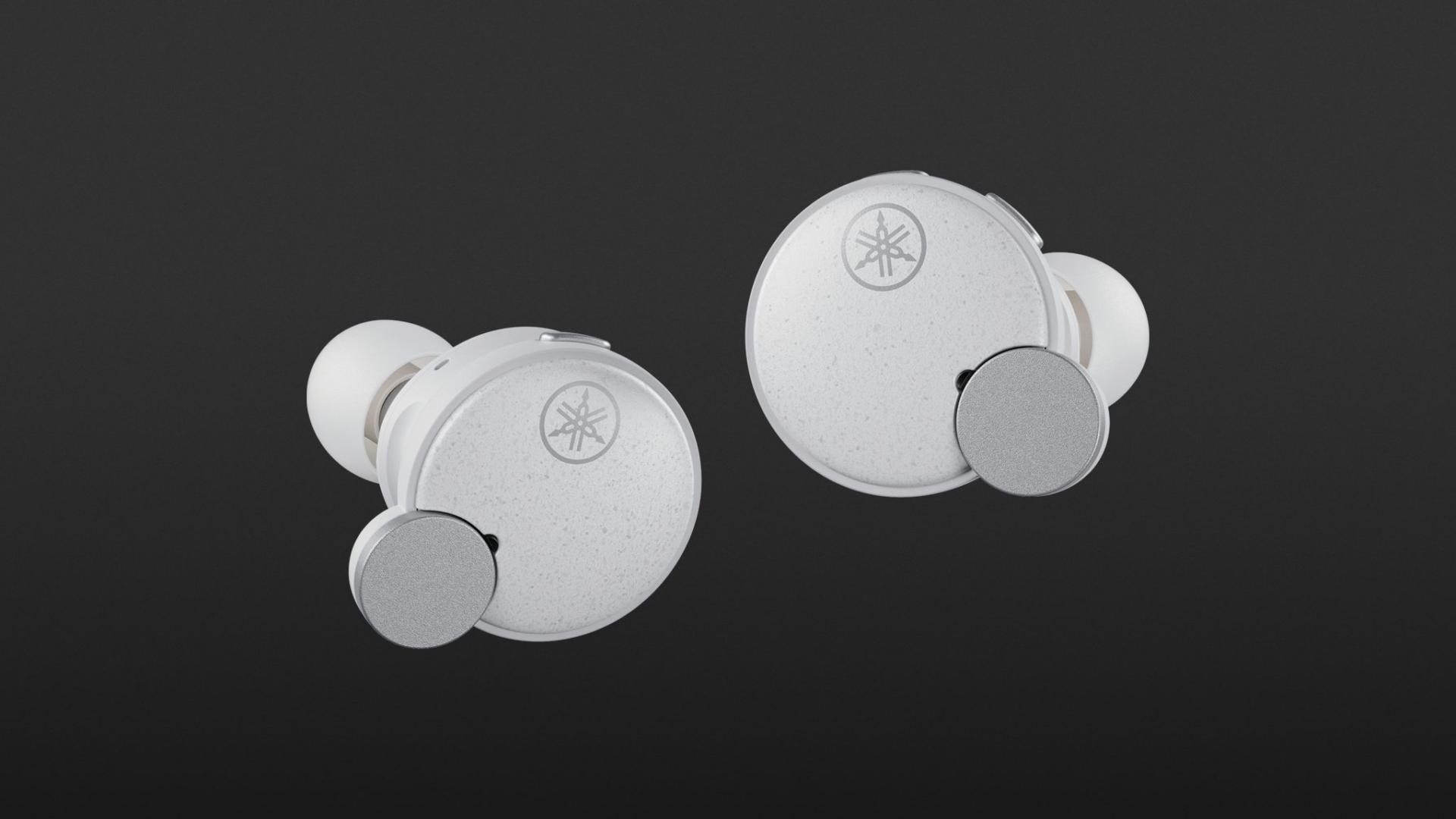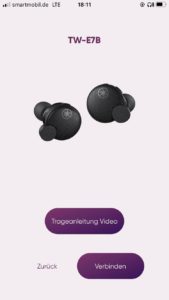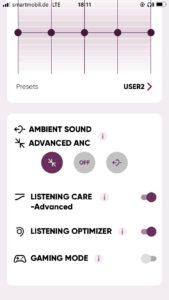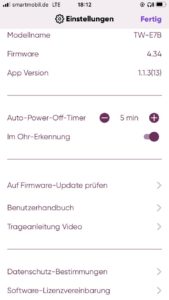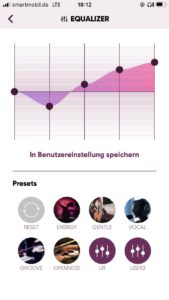The Yamaha TW-E7B sound good, offer effective, straightforward noise cancelling (ANC) and, unlike most competitors, rely on mechanical buttons for function control. A practical, good-sounding accessory for mobile use and communication, though not without weaknesses.
- convincing sound quality
- noise cancelling
- some functions could be more obvious or flexible
- no multi pairing
The TW-E7B are the premium product in Yamaha’s True Wireless range. With a recommended retail price of €269, they vie for favour with products such as the Apple Air Pods Pro 2, the Bose Quiet Comfort Earbuds II, the Sony WF-1000XM4 and the Bowers & Wilkins Pi5 S2.
Design and engineering of the Yamaha TW-E7B
Available in four colour combinations, the Yamaha TW-E7B are ergonomically shaped and larger than typical affordable in-ear models due to a driver size of 10mm. Thus, the design also differs from the smaller TW-E3C and TW-EB models. These in-ears are made of matt plastic and look quite appealing and durable. A small circular outer section with a metal surface provides a decorative element.
The accompanying plastic charging case is robust while not necessarily small. It offers a USB-C interface and four status LEDs. Unfortunately, wireless charging is not provided.
Yamaha deliberately does without touch functions on the TW-E7B and instead relies on a function key on the left and plus/minus keys on the right, each placed on the top of the earpiece – this minimises accidental operating errors.
Technically, the closed TW-E7B features a dynamic driver, offers noise cancelling, an IPX5 certification and support for the audio codecs SBC, AAC and aptX Adaptive. Control is possible via the manufacturer’s Android and iOS compatible App “Headphone Control”.
The Yamaha TW-E7B in practice
Thanks to their ergonomic design, the Yamaha TW-E7B fit securely in the ear. After prolonged wear, they started to pinch a little, at least in my case. The five silicone fitting pieces provided ensured a good seal and, therefore, the desired bass volume. Due to the large housing, part of the housing protruded from the ear, and this could definitely lead to slipping if making quick movements. Consequently, these are less useful as sports headphones than for mobile use – for travel and in the office.
Without reference to active or inactive noise cancelling, Yamaha specifies a runtime of six hours, depending on the volume. The charging case adds another 16 hours of capacity. In practice, this resulted in runtimes that can even survive longer train journeys or air travel. The charging time of the earpieces and case was two to three hours, and a quick-charge function is provided.
The buttons can be used to control playback, volume and even track jumps, and are often supported by voice messages. A double click on the function button switches between the ANC modes. Unfortunately, this also means that you can’t get to transparency mode quickly enough. Phone calls can also be handled with the buttons and likewise, a smartphone voice assistant can be called up.
The app offers a charge indicator, the possibility of firmware updates (status: 4.34), an integrated manual, as well as a five-volume graphic equaliser with pre-sets and two memory locations. Furthermore, there is a specifiable automatic switch-off and switchable detection of the earpiece in the ear. There is also a gaming mode, which is recommended for watching videos to provide lower latencies.
The Bluetooth stream worked stably over several rooms. The app lost the connection to the headphones at times, although music playback did not stop at any point.
Finally, the voice quality during phone calls was clear and distinct. It was only limited by wind noise. The Yamaha TW-E7B is, therefore, also well suited for office use and telephone calls. They also work sensibly with only one earpiece in the ear (single mode). Nevertheless, due to the lack of multi-pairing, we deducted a point here.
How good is the Yamaha TW-E7B’s noise cancelling?
The Yamaha TW-E7B are the only True-Wireless in-ear headphones from Yamaha to offer noise cancelling. The circuit is not adjustable and packs an efficient but not excessive punch. In plain language, low-frequency frequencies and static noises were significantly reduced in level, while erratic signals such as speech or typing noises were less attenuated and remained audible at a reduced level. For travelling in a high-speed train or aeroplane, this was a practical, good performance. I did not notice any sound degradation when noise cancelling was activated in mobile mode. On the contrary, when noise cancelling was activated on the move, there was a clear advantage because the signal-to-noise ratio was improved, meaning you can immerse yourself more deeply in the music. Nevertheless, when noise cancelling was switched off, I noticed an added value in terms of spatiality in quiet environments.
The transparency mode worked as expected. It enabled a better perception of the environment and offered the possibility of communication with the headphones on. However, this mode was not controllable. Switching of the operating modes is fixed in the order “ANC”, “ANC off” and “transparency mode”. Unfortunately, this means that you have to wait for two keystrokes and voice messages when switching to transparency mode.
How do the Yamaha TW-E7B sound?
The coated and, according to the manufacturer, explicitly responsive driver is larger and more powerful in the bass range compared to the Yamaha TW-E5B. The sound of the Yamaha TW-E7B was convincing for the price range: coherent in frequency response and high in resolution.
Roy Orbison’s “The Comedians” revealed the singer’s incomparable timbre, while the accompanying undistorted electric guitars displayed a wonderfully full-bodied attack and a wide but subtle tremolo in the stereo panorama, and the marching snare played comprehensibly further back in the mix.
Kraftwerk’s “Geiger Counter/Radioactivity” (3-D The Catalogue) revealed an impressive panorama with simultaneous depth and imaging of the artificial spaces, which is rare to find in True-Wireless designs.
In the bass range, as mentioned, the TW-E7B proves to be competent and, when required, powerful. The contour, tonality, dynamics, as well as deep bass were reproduced. Booming was not an issue, and I didn’t notice an overemphasis of the higher frequencies.
Voices, instruments and high density in the mix were well brought out for this type of headphone and the price range. Details, timing and good dynamics lead to being able to immerse yourself in the music – sometimes with pleasant proximity or orchestral width. These headphones do not add harshness but instead presented a safe limit to overemphasis. Even rock and metal productions with distorted electric guitars sounded coherent and in line with the mix. In the higher frequencies, the Yamaha TW-E7B offered good resolution, and this also benefited the stereo and spatial imaging. However, the TW-E7Bs did not reach the splendour of more expensive wired products. I sometimes needed to add a discreet treble boost in the equaliser.
As with all the current devices in the TW series, there is an automatic loudness control for sound enjoyment at low volumes, which goes by the name of “Listening Care Advanced”. It is supposed to provide fullness of sound, especially at lower levels. In practice, the effect was quite subtle and not adjustable, plus there were slight switching noises. In my opinion, using the equaliser was the better option. However, the Yamaha TW-E7B actually sounded good even at low levels, which is by no means something to take for granted.
Another function, “Listening Optimizer”, is supposed to regulate the sound quality depending on the fit. At this point, I didn’t hear any difference with well-fitting headphones, while I would manually correct ill-fitting in-ears as a matter of course.
Conclusion
Yamaha has put together a coherent package with the TW-E7B. These headphones deliver a convincing sound performance for their price class, although we are not talking about an audiophile product. Personally, I liked the practical noise cancelling, even if it was less flexible than that of competitor Sony. The operation via buttons instead of touch functions, which are not to everyone’s taste, might be a selling point. There are points deducted for the reduced configurability. The transparency mode could be adjustable and switching between the noise-cancelling modes could be done more elegantly. Multi-pairing should also be something that goes without saying in this price range.
Technical specifications
- Ear couplingIn-ear
- Typeclosed
- Transducer principledynamic
- Frequency response (headphones)20 - 20.000 Hz
- Weight without cableeach 7,3 g
- Cable length20 cm
What's in the box
- 5 pairs of ear tips (XS, S, M, L, XL)
- USB-C charging cable
- charging case
Special features
- Available in black, white, blue and beige
- BT version: 5.2
- BT codecs: SBC, AAC, aptX Adaptive
- BT profiles: A2DP, AVRCP, HFP, HSP




